Table of Contents
Mercedes-Benz: Coolant Mixing with Engine Oil – Causes, Risks & Fixes
When coolant mixes with engine oil, it creates a milky brown sludge that spells trouble for your engine. This contamination usually points to internal failure, such as a blown head gasket, a cracked cylinder head or block, or an oil cooler breach. If left unchecked, the problem can quickly escalate into overheating, oil starvation, or total engine failure.
This guide explores the causes, risks, and fixes for coolant–oil contamination in Mercedes-Benz vehicles, with real-world case studies and step-by-step diagnostics.
Why Coolant and Oil Mixing is Dangerous
Coolant and engine oil serve two very different purposes:
- – Coolant regulates engine temperature and prevents overheating.
- – Oil lubricates moving parts, reducing friction and wear.
When they mix, both fluids lose effectiveness:
- – Lubrication suffers → causing bearing failure and internal wear.
- – Cooling efficiency drops → leading to overheating and gasket damage.
- – Sludge formation occurs → clogging passages, radiator cores, and thermostats.
Common Causes & Symptoms
| Cause | Symptoms | Recommended Fix |
|---|---|---|
| Leaking Engine Oil Cooler | Milky coolant, oil level normal, overheating | Replace oil cooler + gasket, flush cooling system |
| Blown Head Gasket | Oil in coolant and vice versa, overheating, white smoke | Replace gasket, inspect block/head, resurface if warped |
| Cracked Cylinder Head or Block | Persistent oil–coolant mixing, pressure loss, external cracks | Replace or machine head/block |
| Transmission Cooler Leak (rare) | Oil in coolant, transmission fluid drop | Replace radiator or cooler, flush both systems |
Diagnosis & Repair Workflow
When facing coolant and oil mixing, Mercedes-Benz technicians typically follow this process:
1. Visual Checks
- – Look for milky residue in the expansion tank.
- – Inspect the dipstick and oil cap for frothy sludge.
2. Check Levels & Quality
- – Low oil level suggests oil is leaking into the coolant.
- – Milky coolant means contamination from oil.
3. Pressure Test
- – Pressurize the cooling system to detect leaks.
- – Inspect oil cooler, head gasket, or block for seepage.
4. Component-Specific Testing
- – Remove and inspect oil cooler.
- – Check gasket surfaces and coolant return lines.
5. Repair Path
- – Replace faulty components (cooler, hoses, radiator, reservoir).
- – If gasket failure: replace head gasket and machine surfaces.
- – If cracks: replace or repair cylinder head/block.
6. System Flush
- – Flush both coolant and oil systems thoroughly.
- – Use chemical flush, then rinse with distilled water.
7. Final Refill & Test
- – Fill with Mercedes-approved coolant + fresh synthetic oil.
Case Study #1: Mercedes-Benz E Class W212 (M274 Engine)
In this guide, we’ll walk you through what causes of oil in coolant, how to spot the early warning signs, and the diagnostic steps you (or your technician) should take to pinpoint the issue. Whether it’s a blown head gasket, cracked cylinder head, or oil cooler failure, knowing what to check can save your engine and your wallet.
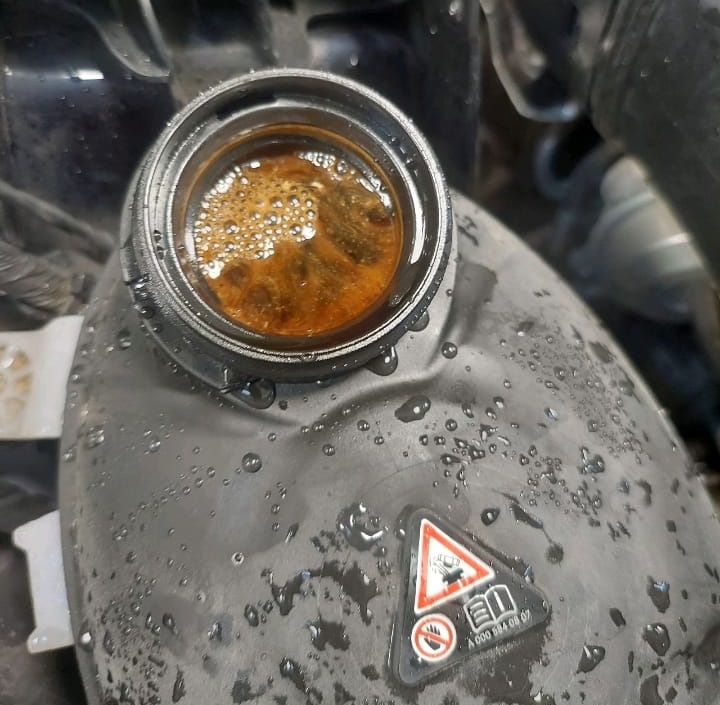
Customer Complaint: Oil in coolant
The customer reported seeing a low coolant warning message on the instrument cluster. Upon further inspection, they also discovered oil present in the coolant receiver tank.
This is a clear sign of Coolant Mixing with Engine Oil, a problem that could indicate multiple underlying issues. The customer sought immediate attention as this could potentially lead to engine overheating and significant mechanical failure.
Initial Diagnosis
When the vehicle arrived at the workshop, we confirmed the customer’s complaint of coolant mixing with engine oil. The diagnostic process began by scanning the vehicle for fault codes. A fault in the Front SAM indicated that the coolant level was indeed low.
After checking the coolant receiver, we confirmed that oil had mixed with the coolant, spilling into the entire cooling system. This oil contamination could affect multiple components, making it essential to identify the root cause swiftly.

Step-by-Step Investigation
1. Checking Engine Oil Level:
The first step was to check the engine oil level, which revealed that it was lower than the recommended range. This indicated that the engine oil was likely leaking into the cooling system.
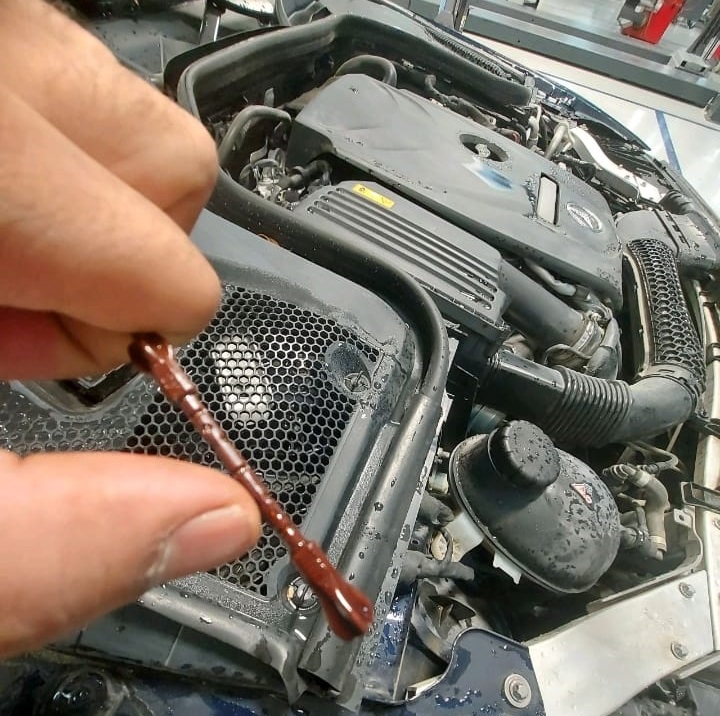
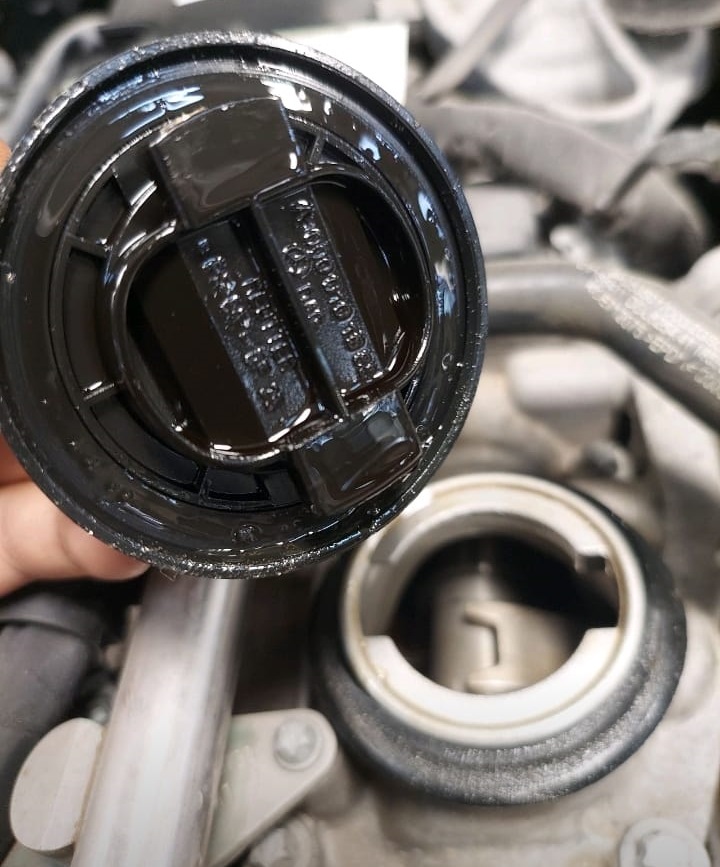
2. Inspection of Transmission Oil Cooler:
Since the transmission oil cooler can sometimes be a source of oil contamination, we inspected it thoroughly. Both the transmission oil cooler and engine oil cooler appeared to be in good condition at first glance.
3. Engine Component Checks:
Next, we examined key engine components, including the spark plugs, cylinder bore, and valves, to check for any gasket leaks. These parts were inspected because a blown head gasket can also cause coolant and oil to mix. However, there were no visible signs of damage or leaks in these areas.
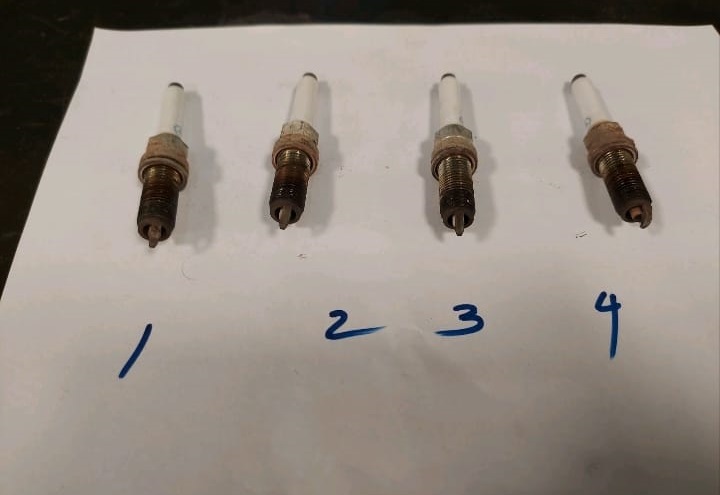
4. Engine Oil Cooler as the Source:
Based on the inspection results and guided diagnostic tests, we confirmed that the “Coolant Mixing With Engine Oil” originated from the engine oil cooler. The cooler had developed internal damage, allowing engine oil to seep into the cooling system.
The Repair Process
Once the issue was diagnosed, we proceeded with the necessary repairs. This involved replacing the following components:
- – Radiator: The radiator was contaminated with oil and needed to be replaced to restore proper cooling efficiency.
- – Coolant Hoses: All coolant hoses were replaced as they were compromised by the oil contamination.
- – Coolant Receiver: The coolant reservoir was replaced since oil residue had adhered to its walls.
- – Engine Oil Cooler: The faulty engine oil cooler was the source of the issue and was replaced, along with the gasket, to prevent further contamination.
System Flushing
After replacing the damaged components, we flushed the entire cooling system to remove any remaining oil residue. This step was crucial as even small traces of oil in the coolant can lead to poor cooling performance and potential future issues.
Final Checks
After the repairs were completed, we performed a comprehensive system check, including:
– Monitoring engine oil levels to ensure no further leakage.
– Checking for coolant leaks or any signs of oil contamination in the new system.
– Running the engine at various temperatures to confirm that the issue had been resolved.
Outcome: Issue resolved. Cooling and lubrication systems restored to full function.
Case Study #2: Mercedes-Benz GLC 300 (M264 engine)

Customer Complaint:
The customer reported a Coolant Level Low message appearing on the instrument cluster. Upon opening the hood and inspecting the coolant expansion tank, the technician observed that the coolant was contaminated the oil in coolant was clearly visible, fully mixed with the coolant and giving it a brownish, milky appearance.

Step-by-Step Diagnosis
When facing oil in coolant, it is crucial to determine the source of the contamination, as this can originate from several components.
1. Initial Inspection
- – Verified the customer’s complaint by opening the coolant expansion tank.
- – The coolant appeared milky and emulsified, a classic sign of oil in coolant.
2. Engine Oil and Transmission Oil Check
- – Checked the engine oil dipstick and found the level lower than normal, suggesting oil loss.
- – Inspected the transmission oil to rule out a transmission oil cooler leak — the transmission oil was clean and at the proper level.
3. Identifying the Fault
Since the transmission oil was fine and the oil in coolant coincided with a drop in engine oil level, the likely culprit was the engine oil cooler. The oil cooler is responsible for maintaining the engine oil temperature by exchanging heat with the engine coolant. If the cooler develops an internal leak, engine oil can enter the coolant circuit.
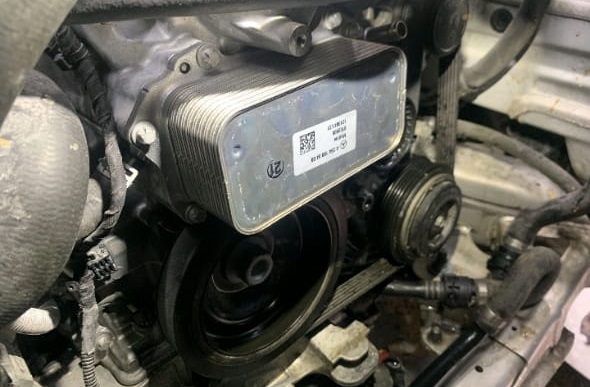
Repairs Performed
Once the diagnosis was confirmed, the following repairs were performed to resolve the oil in coolant issue:
1. Replaced the Engine Oil Cooler and Gasket
- – Removed the faulty engine oil cooler which had developed an internal crack, allowing oil to leak into the coolant.
- – Installed a new OEM engine oil cooler and replaced the gasket to ensure a proper seal.

2. Replaced Coolant Expansion Tank
- – Since the tank was heavily contaminated with oil residue, it was replaced with a new one to avoid re-contamination of the cleaned system.
3. Replaced Thermostat
- – The thermostat was also replaced because oil contamination can affect its proper functioning, potentially leading to overheating.

4. Flushed the Cooling System
- – Performed a thorough coolant system flush several times to remove all traces of oil from the coolant passages, radiator, hoses, and heater core. This step is critical any residual oil can cause long-term damage and reduce the efficiency of the cooling system.
Final Checks
After completing the repairs:
- – Filled the engine with fresh engine oil and coolant.
- – Bled the cooling system to remove air pockets.
- – Ran the engine and monitored temperatures, coolant levels, and oil levels to ensure proper operation.
- – Checked the coolant and oil again after a test drive no further contamination was observed.
Outcome: Contamination eliminated. Preventive replacements (thermostat, expansion tank) ensured long-term reliability.
More Mercedes Cooling System Resources
Want to explore more causes, symptoms, and repair tips for coolant leaks, overheating, and contamination?
Learn more about Mercedes cooling system faults in our full Cooling System Guide.
Why It’s Critical to Act Immediately
Ignoring coolant–oil contamination leads to:
- – Sludge buildup → clogged radiator, heater core, hoses.
- – Oil starvation → bearing damage and piston scoring.
- – Overheating → warped head, cracked block, head gasket failure.
- – Engine seizure → total loss requiring rebuild or replacement.
A Reddit mechanic summed it up bluntly:
“If you try to run an engine with coolant and oil mixed, it will overheat and eat itself.”
Preventive Measures
- – Routine checks: Inspect coolant and oil monthly.
- – Timely servicing: Replace coolant per Mercedes schedule.
- – Watch warnings: Act immediately on low coolant or overheating alerts.
- – Use genuine parts: OEM coolers, hoses, and gaskets last longer.
Conclusion
Coolant mixing with engine oil in a Mercedes-Benz is a serious red flag that should never be ignored. Whether caused by a blown head gasket, cracked cylinder head/block, or oil cooler leak, early diagnosis and proper repair can prevent catastrophic engine failure.
The case studies show that with thorough inspection, precise component replacement, and complete system flushing, vehicles can be restored to safe and reliable operation.
For owners, the message is clear:
=> Pay attention to coolant and oil warnings — they are your engine’s cry for help.
Frequently Asked Questions (FAQ)
Q1: What does it mean if my coolant looks milky?
It usually means oil has contaminated the coolant, often due to a faulty oil cooler or head gasket failure.
Q2: Can I keep driving if coolant and oil are mixing?
No. Driving will cause overheating, oil starvation, and likely engine failure. Immediate repair is necessary.
Q3: How much does it cost to fix coolant–oil mixing in a Mercedes?
- – Oil cooler replacement: $600–$1,200
- – Head gasket replacement: $1,800–$3,500
- – Cracked head/block: $4,000+ depending on parts and labor
Q4: How do mechanics confirm the cause?
They perform pressure tests, compression tests, and component inspections to isolate the source.
Q5: Can a coolant flush alone fix the problem?
No. A flush removes contamination but doesn’t stop the leak. The faulty component must be replaced first.
Q6: How can I prevent oil–coolant mixing in the future?
Regular servicing, monitoring coolant levels, and replacing worn gaskets or hoses before failure are the best preventive measures.
Author
Written by: Mercedes Expert
Automotive Technical Trainer & Mercedes-Benz Diagnostic Specialist
With years of hands-on experience repairing and diagnosing Mercedes-Benz vehicles, specializes in case-study-based troubleshooting guides that blend workshop accuracy with educational clarity.
Last Updated: August 2025

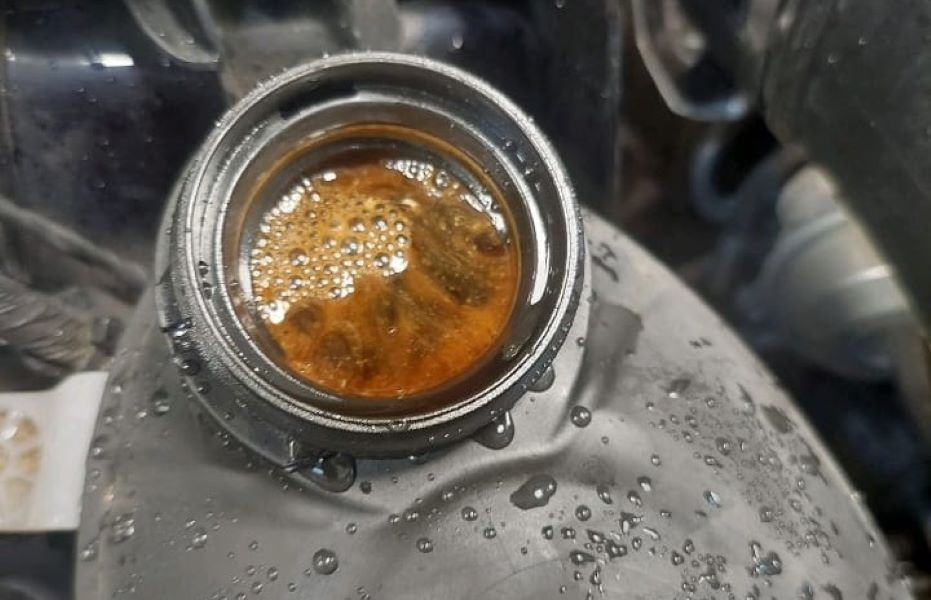
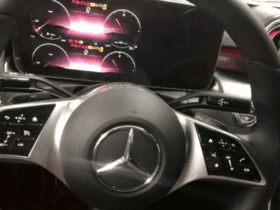


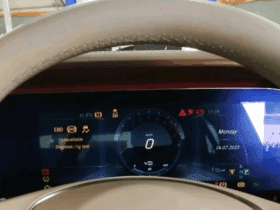
Leave a Reply